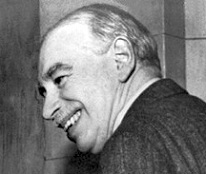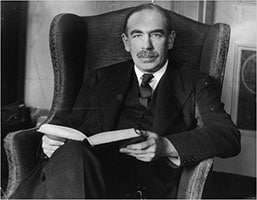 The idea of Keynesianism derives from the thought of John Maynard Keynes , an English economist born in 1883 and died in 1946 . The concept alludes to the principles that this specialist expressed in “General theory of employment, interest and money” , a book that he presented in 1936 .
The idea of Keynesianism derives from the thought of John Maynard Keynes , an English economist born in 1883 and died in 1946 . The concept alludes to the principles that this specialist expressed in “General theory of employment, interest and money” , a book that he presented in 1936 .
Keynes published his most important work as a proposal to overcome the Great Depression of 1929 . That is why Keynesianism revolves around stimulating the economy in a context of crisis.
For Keynes , national states and international institutions should have tools to exercise control over the economy in times of recession . In this framework, it focused on state spending as a vehicle to stimulate activity.
Keynesianism, therefore, considers that fiscal policy is essential to achieve a multiplier effect in the economy, since through it it is possible to increase aggregate demand (that is, the sum of expenditure on services and goods that the State, companies and people are willing to perform at a certain price level).
While the classical theory of economics maintains that the market automatically tends to the full use of the means of production, Keynesianism postulates that there is no such “natural” tendency, but rather that various factors influence it. In this way, it proposes promoting production from the State since, with greater production, there are more goods to exchange and more exchanges occur.
Keynesianism, in short, promotes state intervention in the market - unlike liberalism - to overcome economic depressions through the stimulation of aggregate demand, which generates greater production, investment and employment.
To formalize the theory of Keynesianism it is possible to adopt an approach that considers the purchasing power of a given country and find out what it constitutes at a given point in time. This concept is also known as purchasing power , and is determined by the goods and services that can be purchased with a specific amount of money, taking prices into account.
Purchasing power is directly proportional to the amount of goods and services that we can buy with the same sum of money. In the case of a country, this power is equal to the sum of the income of all its inhabitants, and this will be represented in the formula with the variable Y.
 Since total income must be distributed in savings and investment but also in consumption, every increase in income entails an increase in either of these two factors. In other words, the higher the income, the higher the consumption and savings will be.
Since total income must be distributed in savings and investment but also in consumption, every increase in income entails an increase in either of these two factors. In other words, the higher the income, the higher the consumption and savings will be.
The changes are represented in the formula with the sign Δ (delta), which in mathematics, physics and computer programming is usually used to indicate the variation of a magnitude between two given moments. With respect to savings, we must use the letter A, while for consumption, C. Let us not forget that in this case we are talking about an entire country, which is why we are referring to the savings and consumption of all inhabitants.
Using all of this, we can express the fractional change in two different ways. The marginal propensity to save is understood as the additional saving for each extra unit of income and can be expressed by the following equation: 0 ΔA / ΔY 1 . On the other hand we have the marginal propensity to consume , 0 ΔC / ΔY 1 , according to which the focus is on the additional consumption by the extra units.
If we represent the marginal propensity to save with the variable pma and the marginal propensity to consume as pmc, then we can establish the following equality : pma = 1 – pmc .
